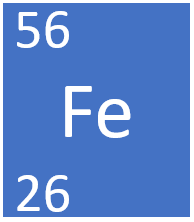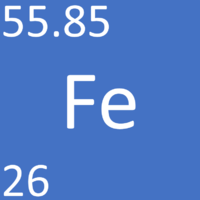Iron
Contents
Key Stage 2
Meaning
Key Stage 3
Meaning
Iron is a transition metal element, on the Periodic Table, with an atomic number of 26.
About Iron
Molecular Structure
- Iron has the chemical symbol Fe.
- Iron atoms join together in large numbers to form a giant metal molecule.
Atomic Structure
- Iron as 26 protons and 30 neutrons in its nucleus giving it an Atomic Number of 26 and an atomic mass of 56.
- Iron is in Period 4 of the Periodic Table because it has 4 electron shells.
Properties
- Iron is a metal element so it is a good thermal conductor and a good electrical conductor.
- Iron is a shiny solid at room temperature.
- Iron is malleable.
- Iron is sonorous.
- Iron is ductile.
- Iron is magnetic.
Key Stage 4
Meaning
Iron is a transition metal element, on the Periodic Table, with 26 protons in the nucleus.
About Iron
Molecular Structure
- Iron has the chemical formula Fe.
- Iron atoms join together in a giant metallic structure.
Atomic Structure
- The most stable isotope of Iron has 30 neutrons in its nucleus giving it an atomic mass of 56.
- Iron is in Period 4 of the Periodic Table because it has 4 electron shells.
- Iron loses electrons to form positive metal ions.
Properties
- Iron forms ionic bonds with non-metals.
- Iron is a metal element so it is a good thermal conductor and a good electrical conductor.
- Iron is a shiny solid at standard temperature and pressure and has a high melting point.
- Iron is malleable.
- Iron is sonorous.
- Iron is ductile.
- Iron is magnetic.
References
AQA
- Iron, page 138, GCSE Combined Science Trilogy; Chemistry, CGP, AQA
- Iron, pages 163, 285, 287, GCSE Chemistry, CGP, AQA
- Iron, pages 216-217, 220-221, 223, GCSE Chemistry; Third Edition, Oxford University Press, AQA
- Iron, pages 242-3, 287, GCSE Physics; Student Book, Collins, AQA

